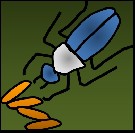Insect control
Crop management practices
These practices both hinder the multiplication of harmful insects and favor rice growth. The most efficient practices are the following:
-
Destruction of rice stubbles and crop residues, i.e. the places where larvae and nymphs can survive between seasons.
-
Respect and synchronization of cropping calendars to avoid insect proliferation.
-
Use of good-quality or treated seeds.
-
Careful monitoring of crops and destruction of primary infection sources, including host weeds.
-
Where possible, avoid mono-cropping and use crop rotations to disrupt insect cycles and prevent proliferation.
-
Associated or row intercropping cultures to limit insect propagation among plants.
To be efficient, crop management practices aimed at insect control must be implemented over large areas. As most farmers manage surface areas of one hectare or less, that means that such practices require agreements and organization over the whole inland valley.
Biological control
Biological control aims at limiting the density of insect pests by using natural enemies as predators, parasites or pathogens. Two strategies may be used, either by preserving or by increasing the density of natural enemies. Preservation simply means that one avoids destroying natural enemies through crop management practices or some interventions like use of pesticides. Increasing natural enemies means that the number of natural enemies will be artificially increased in the environment: this implies that natural enemies will have to be bred and released, and this is difficult to implement in Africa. Therefore, natural preservation will be chosen to increase the population naturally. The most well-known example is that of two parasites of the African rice gall midge: farmers should be told to keep Paspalum scrobulatum (see Reference 22) around their fields, as it is the favorite dwelling of these two parasites. The more this plant grows, the denser the natural enemies, which naturally leads to a decrease in gall-midge populations.
Furthermore, it has been shown that after weeding, putting the weed residues in heaps around the rice straw leads to an increase in spider populations which hide there during the day, and at night hunt the nocturnal stem borers. These methods are called preservation and increase methods, which show that some crop management practices are also biological control practices.
Some other biological control methods can also be used, including in particular the promising use of very specific sexual attracters (pheromones), which, once synthesized, may help destroy insect pests by simply trapping them or can be used in combination with insecticides. This method is beginning to be used for some Lepidoptera attacking fruit. The pheromones of Chilo suppressalis and Chilo zacconius are known and some synthesized components are being tested. Such ‘products’ are very interesting as they may also help ‘predict’ infestations and help choose which kind of control to use, as pheromones allow the detection of very small populations of insects, especially before they begin multiplying. However, stem-borer pheromones are not yet available in Africa.
Biological control has the great advantage of being harmless to health and the environment. Nevertheless, it often demands relatively complex management and requires rather high investments and a certain level of technological expertise.
Genetic control
This type of control requires the use of tolerant varieties; it is usually not very expensive for farmers and imposes few constraints on the environment. Varieties can be differentiated according to the degree of resistance and classified as: low, medium and highly resistant. There are two types of genetic resistance: vertical resistance, to some insects, and horizontal resistance, to most insects.
Chemical control
Chemical control is usually quite affective, as insecticides kill the insects in a short time. Furthermore, insecticides are usually widely available in stores. Nevertheless, insecticides are expensive and impose technical constraints. Spraying liquids is not very precise and less efficient than using granules, which can be applied by hand or with cheap equipment. Some farmers use furadan to prevent stem borers from multiplying. However, the danger of frequently using insecticides is that some insects adapt to insecticides and become resistant. Furthermore, most insecticides are not specific and kill both harmful and useful insects. Using insecticides can therefore be dangerous to the ecosystem and the environment, and such an option should be used only as a last resort, after considering all other possibilities.
Integrated insect control
Integrated insect control means that the populations of harmful insects will be kept as low as possible so that the ecosystem stability is not disturbed and rice cropping can be economically efficient. Integrated control means that one is led to think and to combine judiciously the different control techniques.
Extract from PLAR-IRM Curriculum: Technical Manual (Wopereis et al, 2009)













